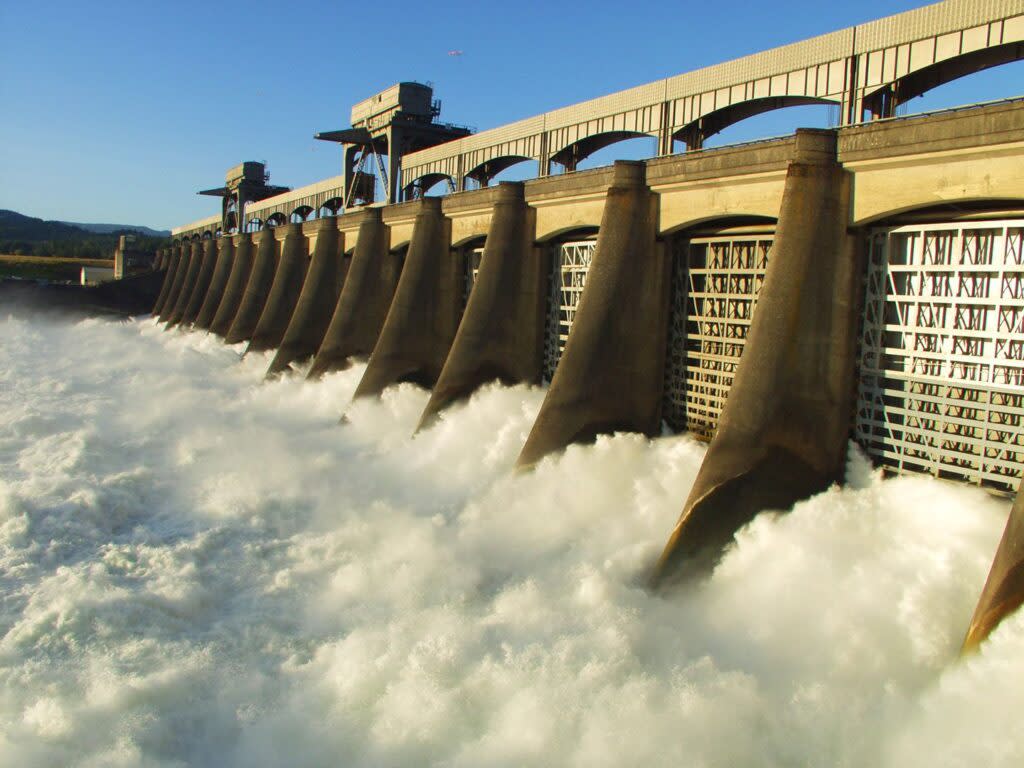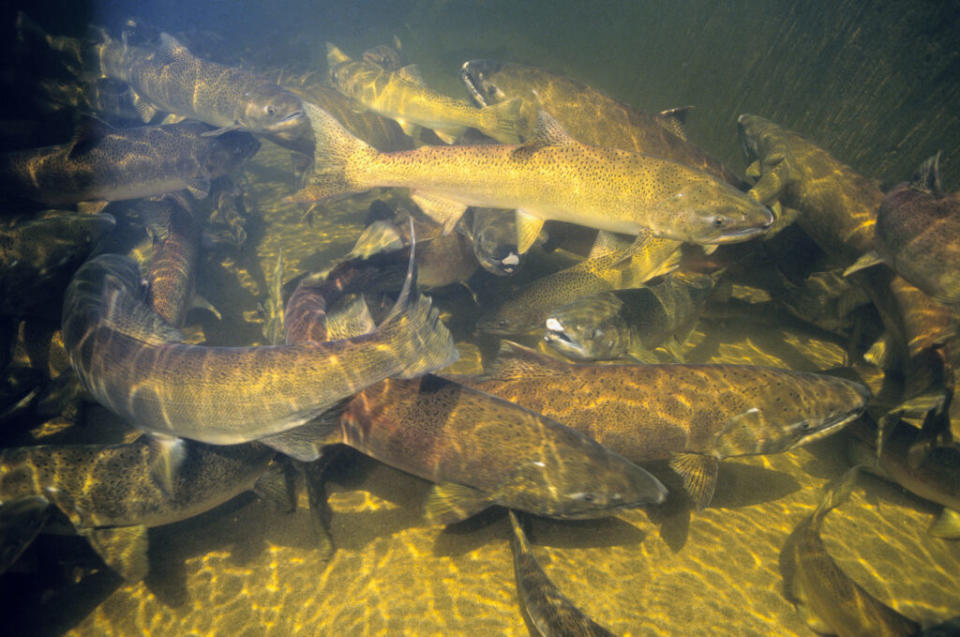Federal government acknowledges dams devastated Northwest tribes and fish stocks

The Bonneville Dam is the last of 14 dams on the Columbia River before it empties into the Pacific Ocean. (Bonneville Power Administration/Flickr)
The federal government this week acknowledged that the construction and operation of 11 hydroelectric dams on the Columbia and Snake rivers during the last century has had a devastating effect on eight Northwest tribes and more than a dozen native fish stocks, some of which have gone extinct.
The acknowledgement came in a report, “Tribal Circumstances Analysis,” that was published Tuesday. It represents the first time that the U.S. government has comprehensively detailed the harm that federal dams have caused and continue to inflict on Northwest tribes, according to a news release from the U.S. Department of the Interior, which undertook the analysis.
Those harms include the inundation of thousands of acres of tribal land and sacred sites and the loss of traditional fishing areas. The government in the analysis acknowledged that it violated treaty promises to the tribes in developing the dams, which brought economic benefits to white settlers – hydropower, irrigation, improved river navigation and mining – while the tribes lost much of their land as well as many of their traditional fishing grounds and the fish they’ve long depended on.
Eight tribes most affected by the dams
Coeur D’Alene Tribe of Indians
Confederated Tribes and Bands of the Yakama Nation
Confederated Tribes of the Colville Reservation
Confederated Tribes of the Umatilla Indian Reservation
Confederated Tribes of the Warm Springs Reservation
Nez Perce Tribes
Shoshone-Bannock Tribes of the Fort Hall Reservation
Spokane Tribe of Indians
“Over a century ago, the government and private interests began damming the Columbia River’s tributaries. These actions, along with many contemporaneous actions, perpetuated and were part and parcel of the historical transfer of land, natural resources and wealth away from the tribes,” the report said. “The government afforded little, if any, consideration to the devastation the dams would bring to tribal communities.”
The analysis follows a series of promises from President Joe Biden to restore native fish populations in the Columbia and Snake River basins and decades of mounting research and litigation pointing to the role of dams in declining native and wild fish stocks and the subsequent decline in the cultural, physical and economic health of Indigenous peoples who have lived for millenia in the basins.
This week, White House officials announced the creation of the Columbia River Task Force to coordinate interagency and tribal work on restoring wild fish stocks in the basins during the next decade. It will be led by Nik Blosser, former chief of staff to Oregon Gov. Kate Brown, a special assistant and deputy cabinet secretary in the Biden administration and, most recently, a vice president at Portland General Electric.
Leaders of the eight affected tribes named in the report lauded the analysis. Shannon Wheeler, chairman of the Nez Perce Tribal Executive Committee, said in a statement it is a “stark reminder” for the federal government.
“We know we must act urgently to prevent extinction, and this report reaffirms the need for the United States and us to move forward together,” he said.
The report also prompted criticism. The nonprofit trade group Pacific Northwest Waterways Association, which represents ports and other economic interests in the area and supports hydropower, said the analysis was “not based on scientific evidence” and deliberately left out other river basin stakeholders.
“Our concerns with the Biden administration’s actions are their excessive lack of transparency and the failure to account for all interests affected by this complex issue,” Neil Maunu, the group’s executive director, said in a statement.
Devastation of fish stocks
The analysis references dozens of studies that have shown that the 11 dams and their reservoirs on the Columbia and Snake rivers have caused the rapid decline of salmon and steelhead populations. It further connects those declines to a decrease in the health and economic well-being of members of eight affected tribes.
Up to 16 million salmon and steelhead historically returned to the Columbia River Basin each year, according to the report. Millions of them migrated hundreds of miles upstream from the ocean to return to their birthing grounds to spawn, including up to 3.7 million salmon and steelhead that returned to the area above what is now Grand Coulee Dam. More than 1 million spring and summer Chinook are believed to have returned annually to the Upper Snake River Basin from the Pacific to spawn.
Tribes in the basin consumed millions of pounds of fish each year, which sustained hundreds of thousands of people as well as more than 130 animal species, according to the report.
Today, four of the 16 salmon stocks in the Columbia and Snake rivers are gone, including coho and sockeye runs, the report said. Some populations have left their historic tributaries, such as salmon and steelhead that used to return to the Umatilla River. Today, seven of the 12 remaining salmon stocks in the Columbia River Basin are federally listed as threatened or endangered.

Half of the historic populations of salmon, steelhead and lamprey that once inhabited the Snake River Basin are also gone. The rest are in a “dire condition” and could become extinct, the report said. It also detailed losses of lamprey and sturgeon that are important to Columbia River Basin tribes, and, with the inundation of land near the rivers, the loss of habitat for elk and deer that were hunted by tribes and where other foods were harvested.
Federal and state governments have supported hatcheries as their key strategy to reverse fish declines, but the operations have failed to fulfill their promise, the report found. Decades of data show that despite billions in taxpayer investment, salmon and steelhead hatchery programs and restoration projects in the Columbia River Basin have failed to support or boost native fish populations and, in fact, are contributing to their decline.
‘Telling the truth’
Officials from the affected Northwest tribes welcomed the report.
In statements Tuesday, they said they were glad the federal government acknowledged the destructive role dams have played in the loss of their land, food, health, cultural practices and economic well-being. Leaders from the Nez Perce and the Confederated Tribes of the Umatilla Indian Reservation said that in publishing the analysis, the federal government was finally being honest.
“The United States – by telling the truth about the historic and ongoing injustices the federal dams have imposed on our people and by embracing its treaty and trust obligations – is upholding the rule of law and highlighting the urgency to act to prevent salmon extinction,” said Wheeler of the Nez Perce.
Corinne Sams, a board member of the Confederated Tribes of the Umatilla and chair of the Columbia River Inter-Tribal Fish Commission, said in a statement that the analysis was “an honest acknowledgment” of the devastating impact that the dams have had on Columbia River Basin tribes.
Three Northwest tribes and federal agencies have begun work on reviving Chinook and sockeye salmon runs that were among the most abundant in the world before the Columbia River dams were built.
As part of that effort, the task force will be charged with coordinating salmon restoration efforts in the Columbia River and Snake rivers across agencies.
The administration said in its release that it chose Blosser to lead based on two decades of experience working on salmon and energy issues. The group will be co-chaired by three people: Laura Daniel-Davis, deputy secretary of the Interior; Deputy Secretary of Energy Dave Turk; and Janet Coit, assistant administrator for fisheries at NOAA. Other members will be from the U.S. Army Corps of Engineers, the U.S. Department of Agriculture, the Environmental Protection Agency, the U.S. Department of Transportation, the Office of Management and Budget and the White House Council on Environmental Quality.
Recommendations
The report made vague recommendations to include the historic effects of the dams in federal environmental reviews on Columbia and Snake River Basin projects. It also called for federal agencies to work with the tribes and to consider the recommendation from the fisheries division of the National Oceanic and Atmospheric Administration to potentially breach the four lower Snake River dams.
NOAA officials have said that breaching the dams would be a good way to restore fish stocks.
Opponents of dam breaching point to another NOAA study showing that warming ocean temperatures from climate change are playing a large role in salmon and steelhead declines as evidence that dam breaching won’t save the fish. The study, by NOAA scientist Lisa Crozier, found that rising sea temperatures were a dominant driver toward future extinction.
But in an email, she told the Capital Chronicle that it’s inappropriate to use her study in discussing historic salmon declines.
“My paper was about the future,” she said.
Dams in Oregon, Washington and Idaho
The 11 dams studied in the report include four in Oregon, six in Washington and another in Idaho.
Lower Columbia River dams in Oregon:
Bonneville Dam (Cascade Locks), completed in 1938
The Dalles Dam (The Dalles), completed in 1957
John Day Dam (Rufus), completed in 1971
McNary Dam (Umatilla), completed in 1954
Upper Columbia River dams in Washington state:
Chief Joseph Dam (Bridgeport), completed in 1977
Grand Coulee Dam (Mason City and Grand Coulee), completed in 1942
Lower Snake River dams:
Ice Harbor Dam (Burbank), completed in 1961
Lower Monumental Dam (Kahlotus), completed in 1969
Little Goose Dam (Dayton), completed in 1978
Lower Granite Dam (Colton), completed in 1979
The report also considers the Dworshak Dam, which was completed in 1973 and is located on the North Fork Clearwater River just upstream of a tributary to the lower Snake River in Ahsahka, Idaho.
GET THE MORNING HEADLINES DELIVERED TO YOUR INBOX
The post Federal government acknowledges dams devastated Northwest tribes and fish stocks appeared first on Oregon Capital Chronicle.

